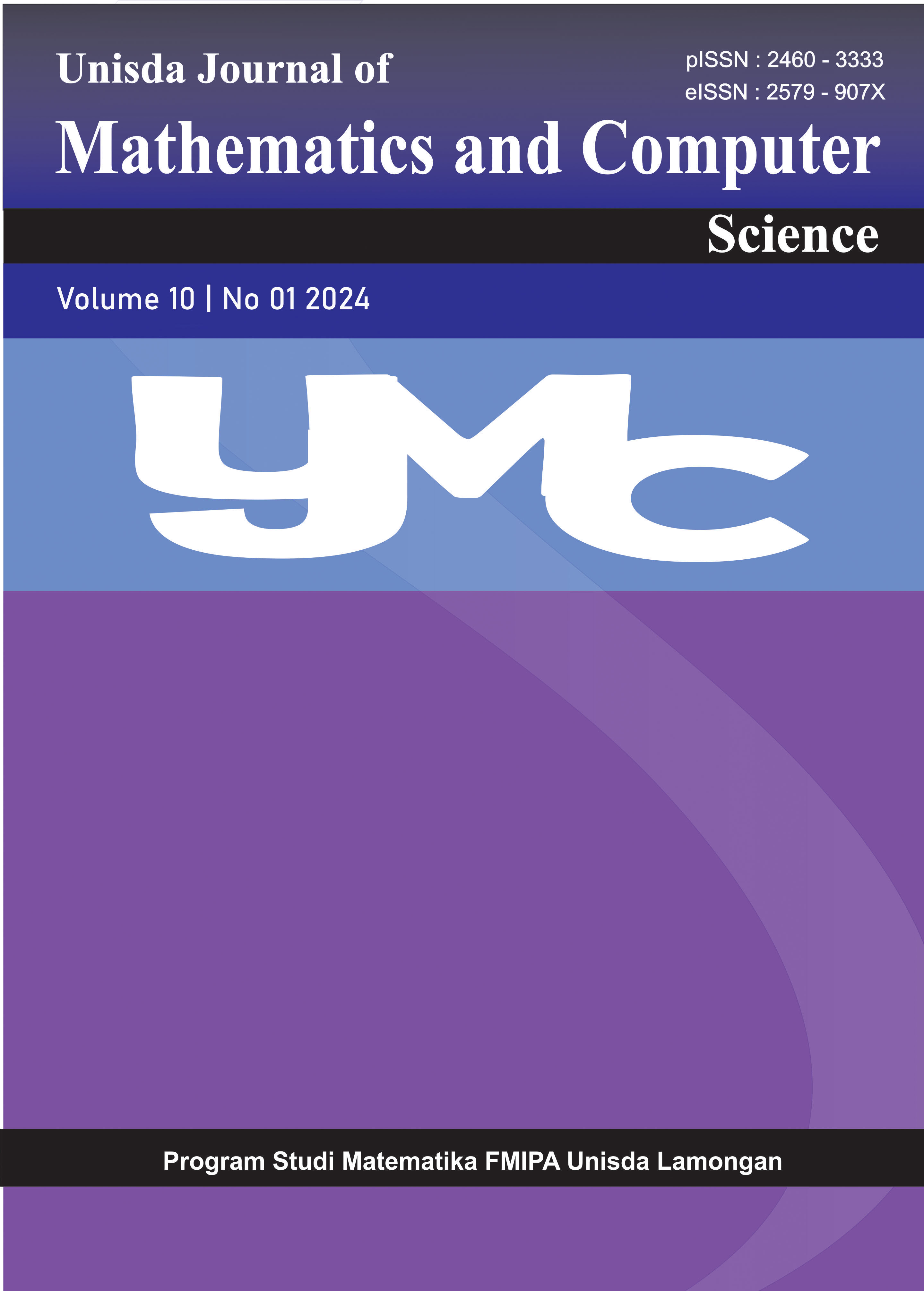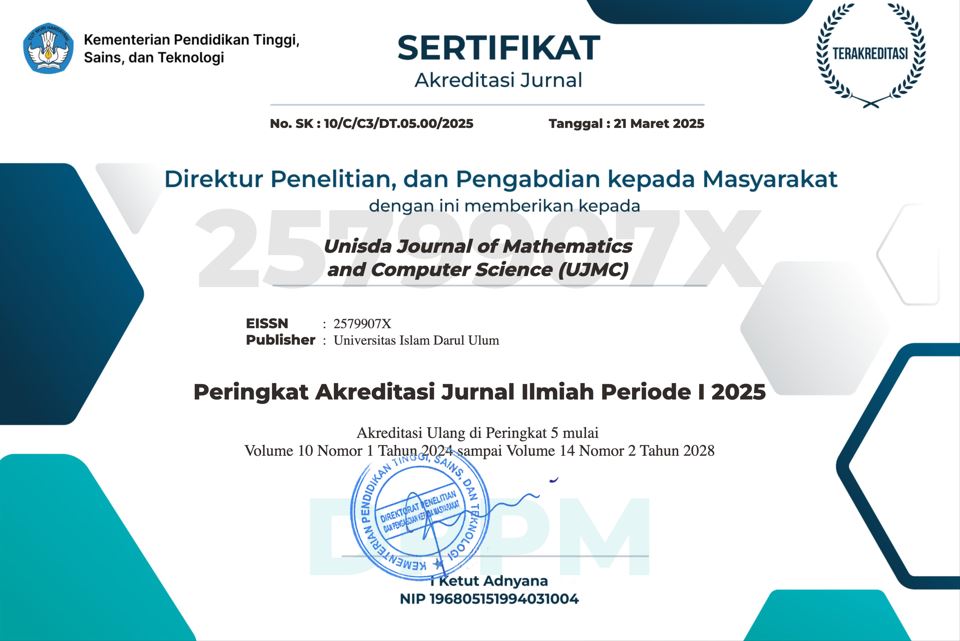Pengelompokan Jumlah Wisatawan Nusantara Menggunakan Fuzzy Learning Vector Quantization
Abstract
Tourism is a variety of tourist activities and support from facilities and services provided by interested parties, such as the community, entrepreneurs and the goverment. Tourists are people who visit a destination outside of their daily activities within a certain period of time. There are several provinces that are classified as having minimal tourists, so they require government evaluation in providing good services in order to increase tourists in terenst in provinces that are classified as having minimal tourists. Therefore, to group the number of tourists, research will be carried out using a combination of data mining and fuzzy logic, namely the fuzzy learning vector quantization method. The research results obtained: For Euclidean Distance, there are 10 provinces in cluster 1 and there are 24 provinces in cluster 2. For squareeuclidean distance, there are 32 provinces in cluster 1 and there are 2 provinces in cluster 2. For city block distance there is 1 province which is included in cluster 1 and there are 33 provinces which are included in cluster 2. For the Chebychev distance there are 10 provinces which are included in cluster 1 and there are 24 provinces which are included in cluster 2. The final result which was chosen as the best is Euclidean however after checking the validity method it is in the formula squareeuclidean with value of PC= 8.32165E+26, CE=-8.94064E+14, and IFV= -1.4892E+13
References
[2] M. S. P. Putra, D. Yustiani and I. N. D. Astawa, "Wisatawan Nusantara Sebagai Pengungkit Ekonomi Bali di Era Pandemi Covid-19," Jurnal Ilmiah Hospitality Management , vol. 12, no. 1, pp. 59-73, 2021.
[3] N. K. Riani, "Pariwisata Adalah Pisau Bermata 2," Jurnal Inovasi Penelitian, vol. 2, no. 5, pp. 1469-1474, 2021.
[4] K. Puspita, F. A. Bachtiar and N. Yudistira, "lasifikasi Aktivitas Manusia menggunakan Algoritme Fuzzy Learning Vector Quantization (FLVQ) dengan Reduksi Dimensi Principal Component Analysis (PCA)," Jurnal Pengembangan Teknologi Informasi dan Ilmu Komputer, vol. 6, no. 1, pp. 154-162, 2022.
[5] J. R. C. Lumansik, G. M. Kawung and J. I. Sumual, "Analisi Potensi Sektor Pariwisata Air Terjun Di Desa Kali Kecamatan Pineleng Kabupaten Minahasa," Jurnal Berkala Ilmiah Efisiensi, vol. 22, no. 1, pp. 13-23, 2022.
[6] I. K. R. Djara, T. Widiastuti and D. M. Sihotang, "Penerapan Logika Fuzzy Menggunakan Metode Mamdani Dalam Optimasi Permintaan Obat," J-ICON, vol. 7, no. 2, pp. 157-161, 2019.
[7] R. Tantiati, M. . T. Furqon and C. Dewi, "Implementasi Metode Learning Vector Quantization (LVQ) untuk Klasifikasi Persalinan," Jurnal Pengembangan Teknologi Informasi dan Ilmu Komputer, vol. 3, no. 10, pp. 9701-9707, 2019.
[8] . K. I. Wardoyo, M. and J. Fredricka, "Klasterisasi Siswa Penyandang Disabilitas Berdasarkan Tingkat Tunagrahita Menggunakan Algoritma K-Means," Jurnal Media Infotama, vol. 16, no. 1858-2680, 2023.
[9] L. F. Obe, D. Lalang, . V. Lakapeni and D. Fatin, "Pengaruh Jumlah Anak Terhadap Pendapatan Hasil Perkebunan Kemiri di Desa Maikang Kecamatan Alor Selatan Tahun 2020 Menggunakan Metode Chi Kuadrat," Jurnal Ilmiah Wahana Pendidikan, vol. 7, 2021.
[10] W. W. Pribadi, A. Yunus and A. S. Wiguna, "Perbandingan Metode K-means Euclidean Distance Dan Manhattan Distance Pada Penentuan Zonasi Covid-19 Dikabupaten Malang," Jurnal Mahasiswa Teknik Informatika, vol. 6, no. 2, 2022.
[11] A. Nurjulianty, P. and H. Darwis, "Perbandingan Metode Naïve Bayes dan K-NN dengan Ekstraksi Fitur GLCM pada Klasifikasi Daun Herbal," Jurnal Media Informatika Budidarma, vol. 7, no. 2614-5278, pp. 1740-1748 , 2023.
[12] G. P. I. Rani, A. Aziz and M. P. T. Sulistyono, "Implementasi Euclidean Dan Chebychev Distance Pada K-Medoids Clustering," Jurnal Mahasiswa Teknik Informatika, vol. 6, no. 2, 2022.
[13] B. S. Hadi, Pendekatan Modified Particle swarm Optimization dan Artificial Bee Colony Pada Fuzzy Geographically Weighted Clustering (Studi Kasus pada Faktor Stunting Balita di Provinsi Jawa Timur), Surabaya, Jurusan Statistika Fakultas Matematika dan Ilmu Pengetahuan Alam Institut Teknologi Sepuluh November Surabaya: Program Magister, 2017.
[14] A. S. Nugroho, I. . M. Nur and M. A. Haris, "Analisis Clustering Dengan Fuzzy Geographically Weighted Clustering (FGWC) Pada Indikator Indeks Pembangunan Manusia di Indonesia," Jurnal Statistika Universitas Islam Muhammadiyah Semarang, vol. 2, no. 1, pp. 27-36, 2021.
[15] A. Bastian, H. Sujadi and G. Febrianto, "Penerapan Algoritma K-Meant Clustering Analisis Pada Penyakit Menular Manusia (Study Kasus Kabupaten Majalengka)," Jurnal Sistem Informasi (Journal of Information System), vol. 14, no. 1, pp. 26-32, 2018.
[16] Vivianti, M. K. Aidid and M. Nusrang, "Implementasi Metode Fuzzy Time Series untuk Peramalan Jumlah," Journal of Statistics and Its Application on Teaching and Research, vol. 1, no. 1, pp. 1-12, 2020 Implementasi Metode Fuzzy Time Series untuk Peramalan Jumlah.
[17] M. Novan, Pengelompokan Siswa Berprestasi Menggunakan Pendekatan Cluster Secara Hirarki dan Non Hirarki, Pamekasan: F. Mipa Universitas Islam Madura, 2020.
[18] M. R. Purnomo , "Pengaruh Media Sosial Terhadap Keputusan Pengunjung Wisatawan ke Curuk Leuwi Hejo Bogor," Tourism Research Journal, vol. 1, no. 1, pp. 1-11, 2022.
[19] E. I. Cahya, Penerapan Metode Fuzzy C-Means pada Pengelompokkan Agen Pulsa, Malang: F. Mipa Universitas Brawijaya, 2017.

This work is licensed under a Creative Commons Attribution-ShareAlike 4.0 International License.
Authors who publish in UJMC (Unisda Journal of Mathematics and Computer Science) agree to the following terms:
1.Authors retain copyright and grant the journal right of first publication with the work simultaneously licensed under a Creative Commons Attribution License (CC BY-SA 4.0) that allows others to share the work with an acknowledgment of the work's authorship and initial publication in this journal.
2.Authors are able to enter into separate, additional contractual arrangements for the non-exclusive distribution of the journal's published version of the work (e.g., post it to an institutional repository or publish it in a book), with an acknowledgment of its initial publication in this journal.
3.Authors are permitted and encouraged to post their work online (e.g., in institutional repositories or on their website) prior to and during the submission process, as it can lead to productive exchanges, as well as earlier and greater citation of published work.









